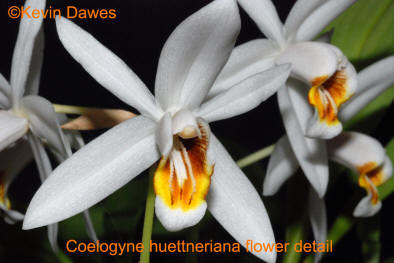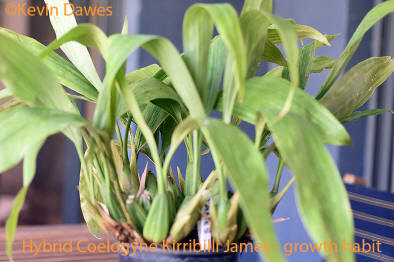Coelogyne Kirribilli James is another new (2014) primary Coelogyne hybrid plant. A primary hybrid is one made by cross-fertilising two species plants. I keep mentioning primary hybrids because there are very few of these in the Coelogynae group. This fact has caused Coelogynes to gain a reputation as being hard to breed. This is another hybrid whose existence is more due to my efforts to prove this theory wrong rather than to a logical choice of parents that could produce a spectacular new orchid.
Coelogyne huettneriana is very closely related to the popular Coelogyne flaccida and often confused with it. They both have numerous, small, very open and white flowers. The only trait that has carried through to the hybrid has been the small size of the flowers. Almost every other trait has been dominated by the pod parent, Coelogyne speciosa. However the keels on the hybrid are smaller, neater and less fimbria-like than Coelogyne speciosa. Also, the lip is narrow and acute compared to Coelogyne speciosa.
I have also made this same hybrid using a variety of Coelogyne speciosa 'Green'. Naming conventions dictate that this newer version must keep the original registered name. However, if I wished, I could add an additional tag onto the end. This Coelogyne speciosa version is very light in colour compared to most Coelogyne speciosa. It has had a dramatic impact on the offspring. They have much larger, lighter, more open and more brightly coloured flowers. It is a significantly improved hybrid.
I will not be adding an additional tag to the name because I will destroy all the original plants - possibly a harsh move but I think a sensible one in the interests of only making available attractive hybrids.
Negatives: The flowers are relatively small, downward facing and they display beneath the canopy. An attractive orchid generally has a good flower display above the leaves. The flower does not not open widely and the flower colour/pattern is far from being in the stunning category .
Rating: ♦♦♦ As is normally the case, room for more orchids is always precious and given the number of very desirable Coelogynes this one will have difficulty getting near the front of the queue.
Registration: Registration with the RHS as Coelogyne Kirribilli James was recorded in September 2014. The hybrid was pollinated on 22.11.2009, flasked 24.11.2010 and flowered for the first time on 25.9.2014.
The hybrid is named after the early Australian pioneer farmer James Dawes who started the Kirribilli family farm in the 1800's. He purchased land from the government with the pre-decimal currency of six shillings and eight pence per acre representing one third of a pound (government land was sold at a fraction of a pound - obviously, calculators hadn't hit town!).
He also conducted a bullock-wagon freight business from the end of the railway line west (at Orange NSW) to outlying farms, delivering supplies and carting wool and hides on the return journeys back to the railhead. In those days, Australia was expanding at an incredible rate. As the railway lines pushed west hundreds of kilometres, they replaced bullock and horse wagon teams as well as the romantic river ferry transport systems.
Eventually, James settled on his farm allotment, 'Kirribilli' clearing the virgin land for sheep and wheat agriculture. Most likely, there were no orchids in the area.
Varieties: None known.
Hybrids: None registered
| < Coel Kirribilli Hubert Dixon | Kirribilli Janet Dixon-Smith > |


